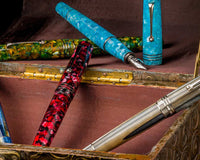The difference between Chinese handwriting and Chinese calligraphy

Before we dive into the pens themselves, it is important to make an important distinction: Chinese handwriting is not the same as Chinese calligraphy.
While calligraphy is, indeed, the most traditional form of writing in Chinese culture, it is now considered a cultural art reserved for special occasions, such as festivals and the Lunar New Year. In everyday life, people use their mobile phones or pen and paper to write Chinese characters quickly.
What constitutes beautiful calligraphy does not necessarily equate to good handwriting. Calligraphy has a more artistic flair to it, and you are often given more freedom of expression. On the other hand, good Chinese handwriting requires the writer to create neat, clear, and easy-to-read characters without mistakes.
You can think of it as the little stylistic additions we have in English cursive lettering when using stub nibs. It’s nice to have, but it isn’t necessary. In the same way, it’s nice to add a little flair using calligraphic techniques, but writing in Chinese characters is easier and better if you focus on stroke sequences, the alignment of each element in the character, and overall neatness.
Nib sizes for Chinese characters

Now that we know the differences between Chinese handwriting and calligraphy, we can move on to the characteristics of the pens that are best suited for Hanzi.
Generally, you’ll want to stick to nibs that can create the thinnest possible lines. Wider nibs may muddle the details and overall look of complex characters, especially if you are writing in traditional instead of simplified Chinese. Extra fine nibs work especially well for this type of writing.
Understanding the sizing differences between brands is also helpful here. Remember that, generally, Western nibs tend to run wider than their Eastern counterparts. This means you’ll have to size down when choosing a fountain pen from a brand like LAMY compared to brands like Pilot or Sailor.
Choosing the right nib size will limit smudging and allow you to write clearly defined characters.
Best pens for writing Chinese characters
Here are some fountain pen options for you if you want to practice Hanzi.
Beginner-Intermediate
Beginner to intermediate writers can benefit from starting with easy-to-use fountain pen models that are also affordable. Most importantly, these pens should have a nib size that is fine enough for character writing.
LAMY Safari - EF

The LAMY Safari is a dependable fountain pen with an ergonomic design to make writing comfortable. This can help you get used to writing Chinese characters, which are typically more detailed and somewhat challenging. Get this pen in the extra-fine nib so you can write neatly.
Pilot Prera - F

Pilot fountain pens usually have narrower nibs than Western nibs, so you can really get into the details of each character. The Prera is lightweight and compact, making it a great choice if you’re on the go. Get this pen in the fine nib.
Platinum 3776 Century - F

The Platinum 3776 Century is known for its performance, with no skipping or hard starts, even when using the finest nibs. This is a little pricier than the first two options, but if you’re going to practice Hanzi for a while, it’s well worth the investment for the fine 14-carat gold nib.
Advanced
Advanced writers may want to add some style to their writing. In this case, you can use specialty nibs.
Sailor Specialty Nib - Naginata Concord

The Naginata Concord from Sailor allows you to write thinner and thicker lines depending on the orientation of your nib. This nib is especially useful for writers who want a truly fine point for their characters while still having the option of writing in thicker lines.
Sailor Specialty Nib - Naginata Fude de Mannen

This bent fountain pen nib (also called a fude nib) gives your characters line variation by changing the angle of your pen. This is suitable for advanced writers who can write with more precision and control.
The Bottom Line
Writing Chinese characters can be challenging at first, but with more practice and the right type of writing instrument, you can create more beautiful Hanzi confidently. Try any of the above recommendations for cleaner, neater, and more legible handwriting.
Written by EndlessPens Blogger Ramona Kabigting







